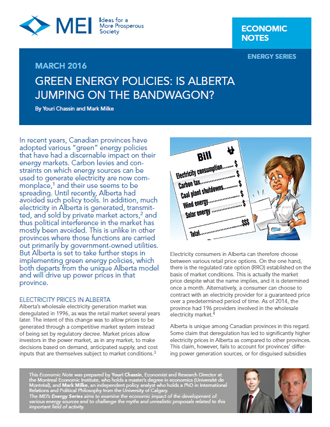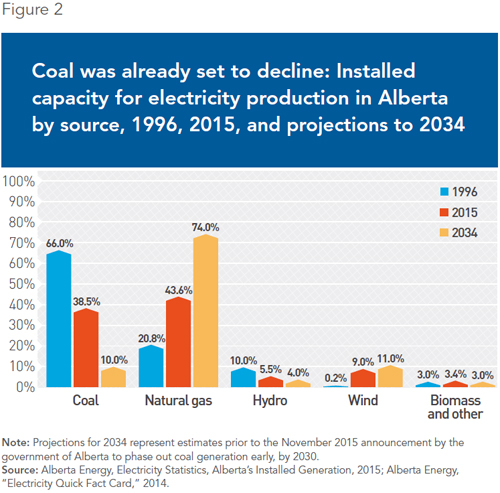Green Energy Subsidies: Is Alberta Jumping on the Bandwagon?

In recent years, Canadian provinces have adopted various “green” energy policies that have had a discernable impact on their energy markets. Carbon levies and constraints on using certain energy sources to generate electricity are now commonplace, and their use seems to be spreading. Until recently, Alberta had avoided such policy tools. In addition, much electricity in Alberta is generated, transmitted, and sold by private market actors, and thus political interference in the market has mostly been avoided. This is unlike in other provinces where those functions are carried out primarily by government-owned utilities. But Alberta is set to take further steps in implementing green energy policies, which both departs from the unique Alberta model and will drive up power prices in that province.
Media release: Hefty bills await Albertans if they follow Ontario and Quebec down “green” path
 Links of interest
Links of interest
 |
 |
 |
|
Get ready Albertans, you're about to pay a steep bill to kill coal (National Post, March 3, 2016)
Come clean on green energy Cost, think-tank urges province (Calgary Herald, March 3, 2016) Albertans in for a shock over power plans (Calgary Herald, May 7, 2016) Hidden costs of capping Albertans’ power bills (Edmonton Journal, December 10, 2016) |
Green Energy Subsidies: Is Alberta Jumping on the Bandwagon?
In recent years, Canadian provinces have adopted various “green” energy policies that have had a discernable impact on their energy markets. Carbon levies and constraints on using certain energy sources to generate electricity are now commonplace,(1) and their use seems to be spreading. Until recently, Alberta had avoided such policy tools. In addition, much electricity in Alberta is generated, transmitted, and sold by private market actors,(2) and thus political interference in the market has mostly been avoided. This is unlike in other provinces where those functions are carried out primarily by government-owned utilities. But Alberta is set to take further steps in implementing green energy policies, which both departs from the unique Alberta model and will drive up power prices in that province.
Electricity Prices in Alberta
Alberta’s wholesale electricity generation market was deregulated in 1996, as was the retail market several years later. The intent of this change was to allow prices to be generated through a competitive market system instead of being set by regulatory decree. Market prices allow investors in the power market, as in any market, to make decisions based on demand, anticipated supply, and cost inputs that are themselves subject to market conditions.(3)
Electricity consumers in Alberta can therefore choose between various retail price options. On the one hand, there is the regulated rate option (RRO) established on the basis of market conditions. This is actually the market price despite what the name implies, and it is determined once a month. Alternatively, a consumer can choose to contract with an electricity provider for a guaranteed price over a predetermined period of time. As of 2014, the province had 196 providers involved in the wholesale electricity market.(4)
Alberta is unique among Canadian provinces in this regard. Some claim that deregulation has led to significantly higher electricity prices in Alberta as compared to other provinces. This claim, however, fails to account for provinces’ differing power generation sources, or for disguised subsidies through provincial utility debt (which could artificially dampen prices in some provinces). According to a London Economics study of industrial and residential rates across Canada in 2013, once such factors were accounted for, Alberta had neither the highest nor the lowest rates in Canada.(5)
In other provinces, electricity prices have soared in recent years due to specific policies aimed at reducing carbon emissions. Quebec and Ontario, for example, have subsidized the use of renewables in the production of electricity. This new production is notably more expensive than previous projects. Both provinces also find themselves in surplus situations in which the resale price of this additional electricity does not cover its cost. As a result, households and businesses are paying higher rates to cover these losses.(6) The environmental benefits of such policies are generally recognized as more expensive than other, fiscal types of climate change interventions.(7)
Relative to other provinces, electricity prices in Alberta have been attractive in recent years, although it is true that they have been quite volatile. This is mainly due to the volatility of the price of natural gas, which accounted for 35% of Alberta’s electricity generation in 2014.(8)
Over the long term, though, electricity prices in Alberta have not risen very quickly (see Figure 1). From 2002 to 2015, they rose just 15.7%, slower than the overall consumer price index (33.7%) and much slower than certain consumer items delivered by government such as city bus and subway transportation (68.7%) and water prices (90.7%).(9)

Recent Developments in Government Electricity Policy
With the election of a new provincial government in May 2015, there has been a distinct policy shift in Alberta, including on power generation and on carbon emissions. In November 2015, the provincial government announced a plan to increase the tax on carbon emissions by $3 billion.(10) Alberta already imposed a conditional $15 per tonne carbon tax in 2007,(11) which is now set to increase to $30 per tonne by 2017.(12) The tax is not revenue neutral,(13) contrary to British Columbia’s carbon tax, and will cost the average Alberta household $480 annually by 2018, and double that amount by 2030, according to a report commissioned by the Alberta government.
In addition, the government has announced that coal-fired electricity generation must be shut down by 2030.(14) Alberta’s installed electricity generation capacity from coal has already declined from 66% in 1996 to 38.5% in 2015, and was set to fall to 10% by 2034 before the new policy announcement (see Figure 2). Of 18 coal-fired power plants in Alberta, 12 were already scheduled to cease operations by 2030, with the remaining six to close between 2036 and 2061.(15)

The new policy therefore accelerates the shutdown of these last six plants, but at a significant cost to consumers, taxpayers, and shareholders. For example, TransAlta, with five coal-fired plants, has announced that its dividend will be reduced due to their accelerated shutdown.(16) Companies will also likely respond by increasing retail prices. This is well illustrated by the government’s own Climate Leadership report, released in November 2015 and endorsed by the government as a basis for policy action.
The cost of replacing coal-powered electricity generation with more expensive renewable alternatives will also likely be passed on to consumers in the form of higher electricity prices. One Standard & Poor’s analyst estimates that $7 billion in additional debt will be contracted by power companies required to build green energy projects sooner than expected.(17) This debt will likely entail some kind of government support. According to the authors of the Climate Leadership report, “incremental renewable energy support will be required at a scale of [2.5 to 3.5 cents per kWh] initially, with potential for decreases over time.”(18)
Others think these estimates are too low. One report prepared by EDC Associates Ltd., an independent electricity consulting firm, estimated that for such incentives to attract investment, the subsidy would need to be between 6.0 to 8.5 cents per kWh for wind, and higher for solar.(19) Whatever the actual level, it’s clear that these financing costs will be borne ultimately by consumers, either directly or as taxpayers.
Additionally, the early phase-out of electricity generated from coal plants may create obligations for government to compensate companies that own coal-fired facilities. The Climate Leadership report authors noted that the early phase-out of coal-generated power may negatively affect some Alberta communities and that “the government should be prepared to provide appropriate adjustment programs.”(20) The early shutdown of coal-fired plants entails compensation estimated at between $5 billion and $15 billion.(21) This will result in higher costs for Albertans either as consumers, or as taxpayers, or both.
The Climate Leadership report readily recognizes that the carbon tax, the expedited shutdown of coal plants, and the subsidies for green energy will lead to higher costs, demands for taxpayer- or consumer-financed compensation for utilities, and explicit subsidies. These government policies will increase power costs for consumers and taxpayers in Alberta above and beyond existing expected increases.
A Cautionary Tale from Ontario
The experiment upon which Alberta is embarking is not novel. Ontario also expedited the transition to alternative energy over existing power production, most notably from coal. In 2006, Ontario’s Ministry of Energy issued a directive to the Ontario Power Authority (OPA) to end all coal-fired electricity generation, about one-quarter of the power generated at the time. This capacity was to be replaced with power sourced from renewable energy such as wind and solar.(22)
As noted by Ontario’s Auditor General, the province was already in the process of removing coal-fired power from the electricity grid before the 2006 directive. Between 2003 and 2014, the province removed 7,546 MW of coal-produced electricity while adding 13,595 MW of new capacity (6,580 MW from renewables, 5,674 MW from natural gas, and 1,341 MW from nuclear). The province did this through guaranteed price programs: one before 2009 which used competitive bidding but still required subsidies, and a post-2009 program, the Feed-In Tariff, which required even higher subsidies.(23) As the Auditor General noted in her 2015 report, “the new [post-2009] guaranteed price program was wider in scope and offered generators significantly higher prices.” Power prices in Ontario grew from 5 cents per kWh in 2004 to 9 cents per kWh in 2014, an 80% increase.(24)
Oddly, as the Auditor General also noted, Ontario experienced an average annual power surplus of 5,160 MW between 2009 and 2014. In a normal market situation, a surplus leads to a decrease in prices, but because this surplus was due to the province’s continued subsidies and encouragement to alternative energy production, Ontario’s consumers saw no such fall in prices. Overall, the Auditor General concluded that excessive prices were paid for renewable energy, even though the province has offered lower guaranteed prices for renewables over the past several years than it did initially in 2009.
Over and above the amount that the pre-2009 program would have cost Ontario’s consumers, the Auditor General found that an additional $9.2 billion will be paid to alternative power producers over the 20-year term of their contracts.(25) In 2014, despite having fallen, Ontario’s guaranteed prices were still double the average U.S. cost for wind energy, and three and a half times the average cost for solar energy.(26) Had Ontario simply committed to paying the average cost for solar and wind for the negotiated contract time, Ontarians would have been far better off.
Conclusion
Alberta’s Climate Leadership report is clear that alternative energy power generation in Alberta will require government support, as it has in Ontario and elsewhere.(27) Based on the report, and on Ontario’s experience as detailed by its Auditor General, we can expect that Albertans will pay a lot more for power in the future, both as consumers (through higher rates and a higher carbon tax) and as taxpayers (to subsidize early coal plant shutdowns and alternative power generation) if the announced policies are indeed adopted.
No precise estimates have been made public yet, however. In the spirit of transparency, the government should be upfront about these costs so that Albertans can have an honest, informed debate about the wisdom of the policies that they will be called upon to finance.
This Economic Note was prepared by Youri Chassin, Economist and Research Director at the Montreal Economic Institute, who holds a master’s degree in economics (Université de Montréal), and Mark Milke, an independent policy analyst who holds a PhD in International Relations and Political Philosophy from the University of Calgary. The MEI’s Energy Series aims to examine the economic impact of the development of various energy sources and to challenge the myths and unrealistic proposals related to this important field of activity.
References
1. British Columbia has a carbon tax, Quebec is part of a carbon market with California that Ontario and Manitoba intend to join, wind and solar power are subsidized in various provinces, etc. See Youri Chassin and Guillaume Tremblay, Practical Guide to the Economics of Climate Change: The Paris Conference and Its Aftermath, MEI, November 2015, pp. 29-49; Office of the Premier of Ontario, “Memorandum of Understanding Between the Government of Ontario, the Government of Québec and the Government of Manitoba,” Press release, December 7, 2015.
2. There are a few local exceptions, namely city utilities in Edmonton, Calgary, and a few other cities that don’t have monopolies and where other market actors are allowed to compete, as is the case across Alberta.
3. Because the transmission and distribution functions of electricity were deemed inherently monopolistic (i.e., one power line and not twenty), the decision was made by the province to continue to regulate the transmission side of Alberta’s electricity sector.
4. Alberta Electric System Operator, 2014 Annual Market Statistics, February 2015, p. 2.
5. London Economics International, Power Prices in Context: Comparing Alberta-delivered electricity prices to other Canadian provinces on a level playing field, June 2014, pp. 28-29.
6. Youri Chassin and Guillaume Tremblay, op. cit., footnote 1.
7. OECD, Effective Carbon Prices, November 2013, p. 12.
8. Alberta Energy, Electricity Statistics, Alberta’s Electricity Generation – 2014.
9. Statistics Canada, CANSIM Table 326-0020: Consumer Price Index, annual (2002=100), 2002-2015.
10. Government of Alberta, Climate Leadership Plan speech, November 22, 2015.
11. Kaitlyn Mason, Calgary Chamber of Commerce, Unpacking Alberta’s Climate Change plan: Part I – Distilling the carbon tax, November 24, 2015.
12. Alberta Government, Climate Leadership Plan, Carbon Pricing.
13. The province has promised to mitigate the impact of this extra $3-billion carbon tax on low income earners, but this will not offset the full increase. In addition, when governments spend money on subsidies—even for defensible reasons such as shielding low-income earners—this is counted as an expenditure in public sector accounting, and so the tax is not revenue neutral by any measure. Government of Alberta, Climate Leadership: Report to Minister, November 20, 2015, pp. 31 and 42.
14. Ibid., pp. 6 and 12.
15. Alberta Energy, “Electricity Quick Fact Card,” 2014.
16. TransAlta, “TransAlta Announces Key Actions to Support Transition to Clean Power,” Press release, January 14, 2016; TransAlta, Our Business, Coal, February 20, 2015.
17. Jeremy Van Loon, “Alberta’s move to green energy seen adding $7 billion in power company debt,” Financial Post, December 2, 2015.
18. Government of Alberta, op. cit., footnote 13, p. 58.
19. Duane Carlson and Allen Crowley, “EDC’s Impact Assessment of Climate Leadership Plan,” EDC Associates Ltd., prepared for IPPSA, January 25, 2016, slide 37.
20. Government of Alberta, op. cit., footnote 13.
21. Duane Carlson and Allen Crowley, op. cit., footnote 19.
22. Office of the Auditor General of Ontario, Annual Report 2015, Chapter 3, Section 3.05, “Electricity Power System Planning,” p. 208.
23. The Alberta Climate Leadership report did caution against feed-in tariffs for Alberta (p. 51). Nevertheless, whether the subsidy takes the form of Ontario-style feed-in tariffs or of some “made in Alberta” type of subsidy by another name, the Alberta government clearly intends to subsidize alternative energy at the expense of industry, consumers, or taxpayers—or all three.
24. Ibid., pp. 208 and 214.
25. Ibid., pp. 215 and 225-227. The Auditor General also cites the Independent Electricity System Operator, which calculates this amount to be closer to $5.3 billion, in order to reflect the “time value of money,” which is the idea that money available today is worth more than the same amount at some future date due to its potential earning capacity.
26. Ibid., pp. 226-227.
27. Government of Alberta, op. cit., footnote 13, p. 49.

